Summary:
In this post, I will reveal the ultimate social media checklist and best social media practices (down to the nitty-gritty) to optimize your efforts.
You’ll love this post if you want to know the best social media marketing checklist to scale your busines:
Daily Checklist
- Respond to all comments and direct messages on all social media accounts
- Check for mentions and notifications across all social media accounts
- Post fresh and relevant content
- Engage with relevant accounts and posts
- Research keywords, hashtags, and trending Topics
Weekly Checklist
- Create and schedule content on your content calendar for the next week
- Track and analyze your performance metrics on social media platforms
- Analyze your competitors
- Track weekly goals
- Connect with an influencer
Monthly Checklist
- Conduct a social media platform audit
- Create and share a monthly analytics report
- Conduct an audience analysis to understand your audience
- Revise and Touch up Your Social Media Strategy
Organize and Thrive: Your Ultimate Social Media Checklist for 2025
Social media is a world of its own with its unique complexities. There’s always an opportunity or a trend to capitalize on for brand visibility, reaching new customers, or engaging with fans.
Over 5 billion people use social media daily. If your business (big or small) is not meeting your audience halfway on social platforms, then you are seriously missing out.
Social media managers must wear many hats, from creating video content to writing a post. Every time, their thoughts are “What should I do next?” “Am I missing something?” or “What boxes do I need to check out?”. It’s a never-ending cycle…but, it doesn’t have to be difficult.
It’s not enough to publish a few posts, you must be active and consistent. As a social media manager, you don’t want to miss an opportunity to interact with your audience or miss important tasks.
This is why you need a social media management checklist as a reference.
Walk with me.
Why Is A Social Media Management Checklist So Important?
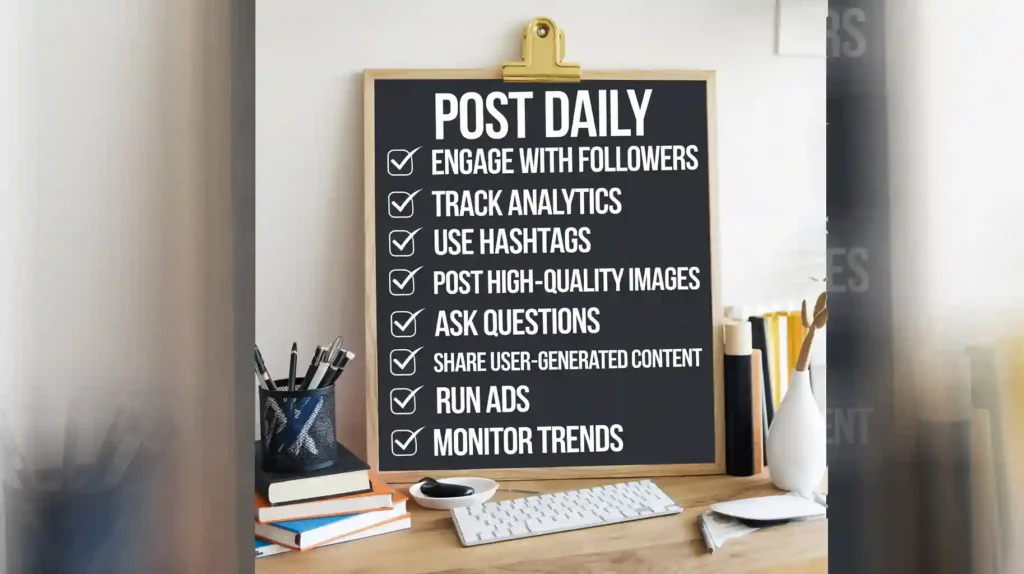
Social media management is a full-time schedule. Many tasks and activities must be accomplished, which vary in frequency and need. So, you need a social media checklist to have a bird’s-eye view of everything. You also track your social media efforts and metrics.
A social media checklist won’t magically do all the heavy lifting for you. However, it will guide you through the tasks you need to handle. It also helps you manage your social media accounts better.
Using a checklist makes it easier to navigate your social media content strategy and stay on track.
For example, you own a fitness brand that does well on Instagram but forgets to respond to comments. Using a checklist will help you respond to comments daily and monitor brand mentions to understand what your customers and audience think (and say) about your business.
Checklists help know (exactly) what to do and when to save valuable time. For example, you run an online bakery and post about your weekend specials. To make the most out of your business, adjust your strategy monthly.
Using a checklist will prevent you from dedicating much of your day to activities you should do less frequently. So, your time is not wasted on activities that don’t help you achieve your goals.
Bottom line:
A social media audit checklist is a road map for your online presence. Without it, you can miss opportunities, waste time, or even confuse your audience and yourself.
Nevertheless, for a social media checklist to work, you need an established social strategy to guide you. Then, follow up with these daily, weekly, and monthly social media checklists.
Daily, Weekly and Monthly Social Media Checklist
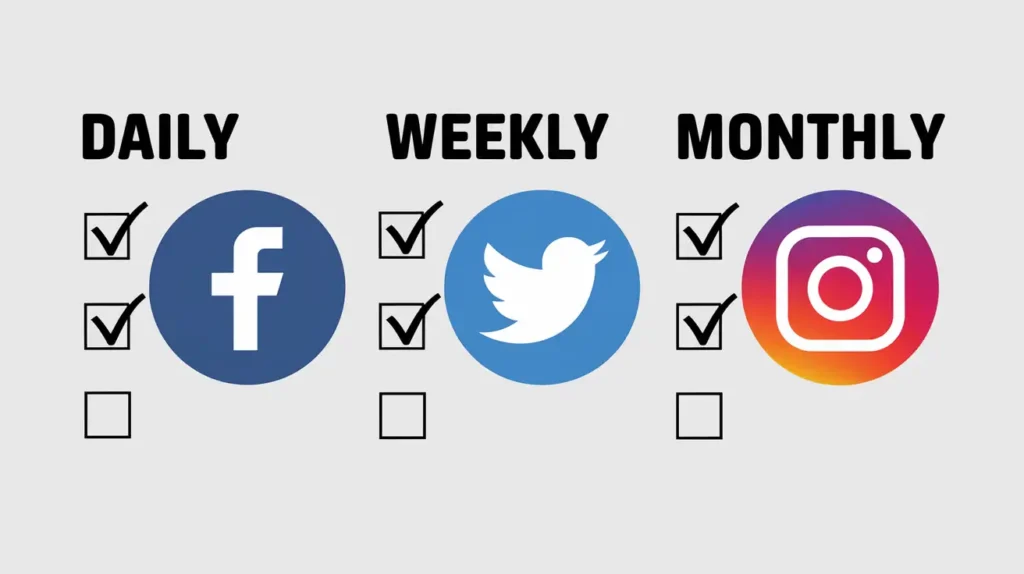
Social media managers start their day like normal people do. Yet, once their eyes are unglued and their brain is charged, here’s what they need to do:
Daily Social Media Marketing Checklist
These are the social media activities you should do daily.
1. Respond To All Comments and Direct Messages On All Social Media accounts
Here’s the truth:
Not replying to comments and DMs is as good as saying, “I don’t want your engagement” or “I don’t care what you think about my business.” Over 69% of consumers expect a response within 24 hours.
As a social media manager, I understand you have a lot going on during the day. Nevertheless, people who organically engage with you on social media would appreciate prompt responses.
Why?
It tells your audience that you are interested in their opinions and appreciate their engagement. This helps generate more engagement. Audience engagement rate is a key metric social media channels use to prioritize posts in a newsfeed.
Ergo, the more authentic engagement you have on your post, the more people see your content. This ultimately grows your audience or customer base and community.
Comments can be customers leaving feedback or sharing challenges they experienced while using your product. See how this company CVJury replies to comments on their Pinterest and LinkedIn posts:
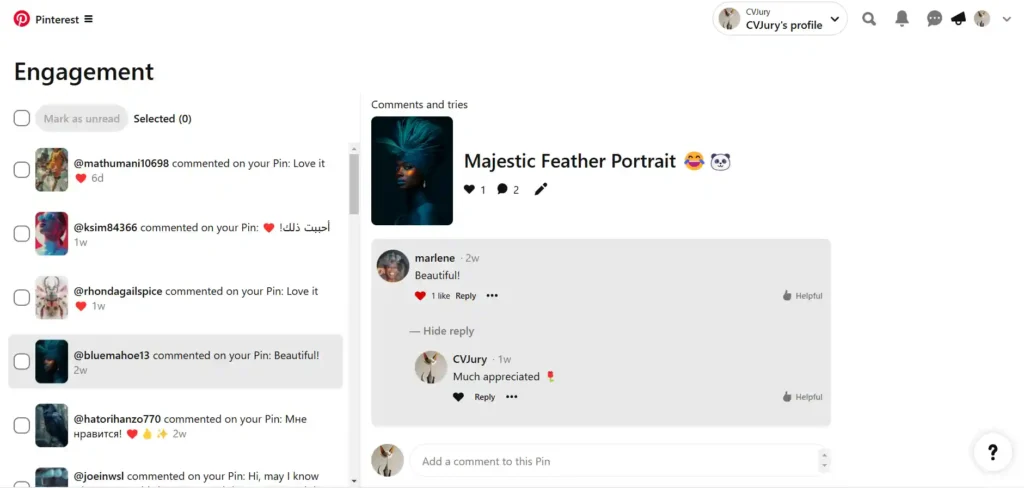
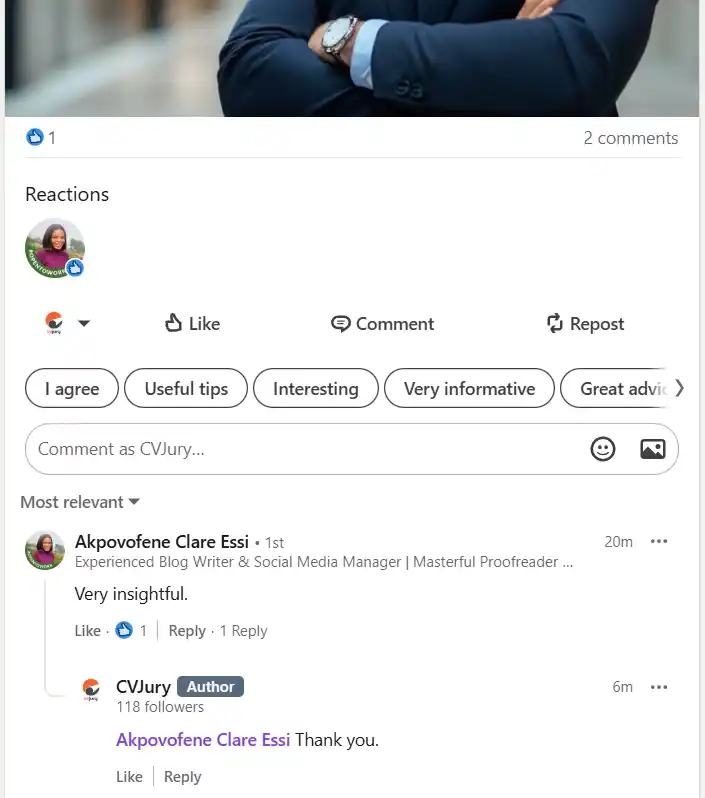
Also, always check your inbox (across all your social platforms) and respond to your direct messages. Sometimes, your audience may send DMs when they have a question for you.
Be professional when you reply. This can give your brand a positive reputation.
Social media tools like Semrush Social Inbox or Buffer integration can help you track and reply to comments and DMs across your social channels.
Tips for replying to negative/positive comments or DMs:
- Reply as quickly as possible. Set up push notifications if you have to.
- Be courteous, professional, and friendly.
- Provide thorough answers to questions.
- Apologize when customers give negative comments, acknowledge your mistake, and provide a way forward.
2. Check for Mentions and Notifications Across All Social Media Accounts
Checking your brand mentions (BMs) is similar to checking and replying to comments and DMs.
But why should you monitor mentions?
Monitoring your mentions is important because it will give you insights into what your target audiences say about your brand.
But here’s the kicker:
Tracking your BMs helps you identify negative feedback and potential crises before things get out of hand. This means you can assess brand sentiment and quickly leverage concerns to manage your brand’s image and reputation online.
You can track what your target audience says about you with Semrush ’s Brand Monitoring app. Simply sign up and enter your domain and email address to create a query:
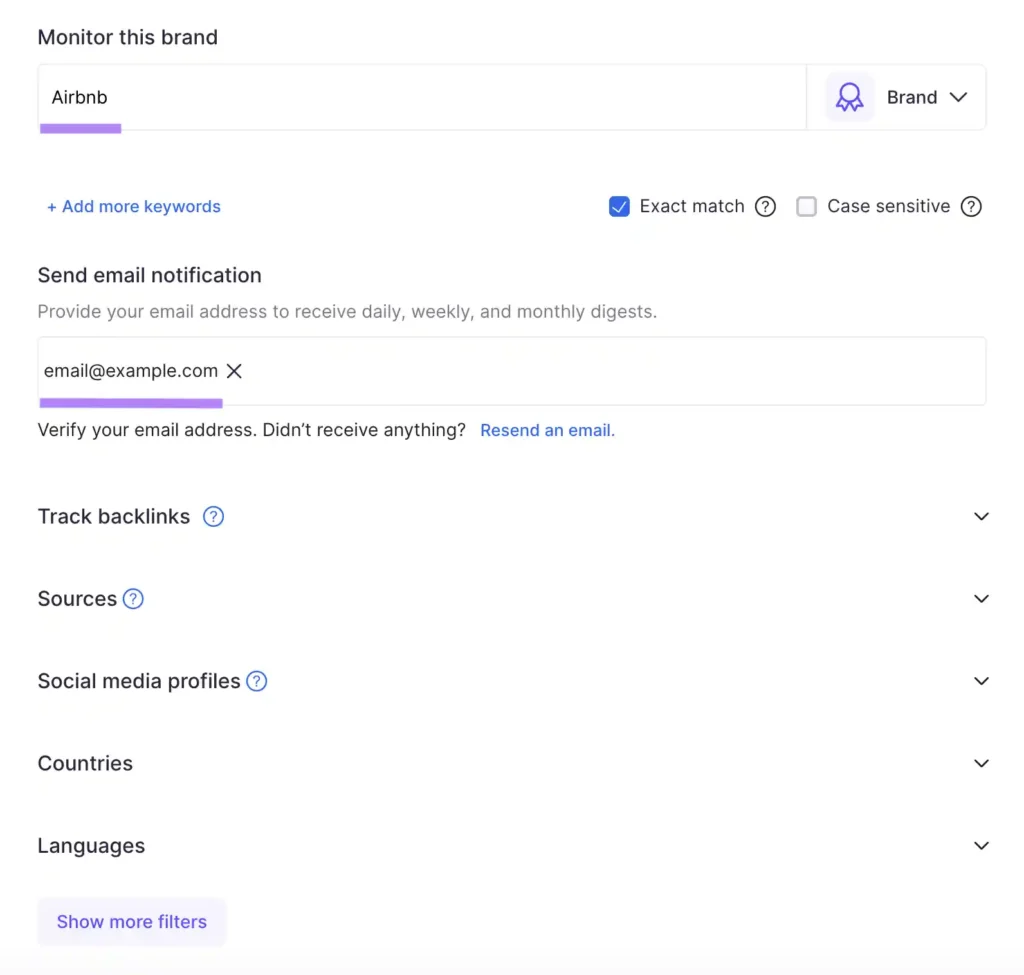
Arrange your settings and then create a query:
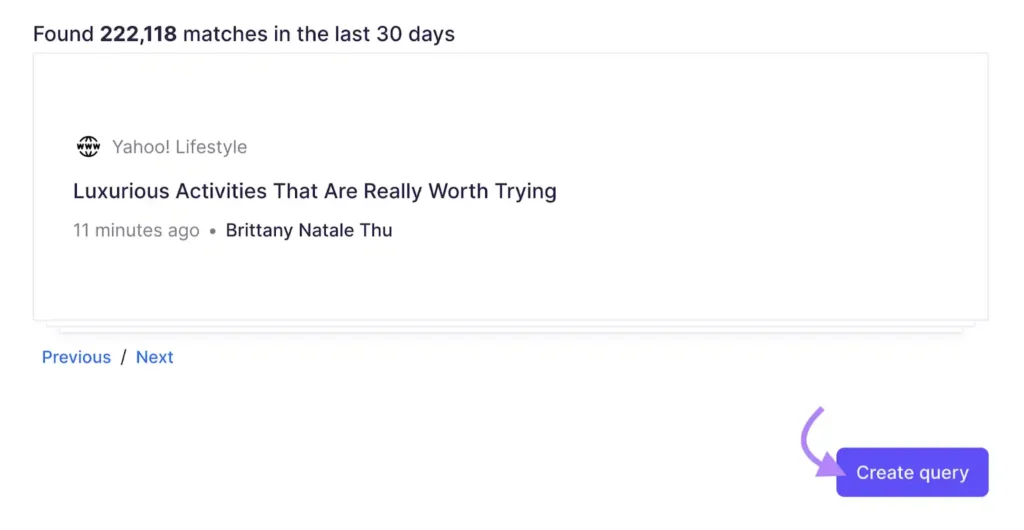
3. Post Fresh and Relevant Content
Your content is at the center of your social media strategy. Without it, you cannot build brand awareness, drive website traffic, or spark engagement. Posting fresh content will validate your online authority and involve you in relevant discussions.
So every day, take some time to review your content calendar. And add new content ideas if you must.
But if you have content scheduled to go live for the day, ensure nothing is missing that would make your content inaccurate.
For example, if you’re sharing a post about a new product launch, check if the price in the image matches the one listed on the website. Or confirm the promotional discount mentioned is still valid and hasn’t changed at the last minute.
Small errors like these can confuse customers and hurt your social media campaign. The last thing you want is inconsistent or lousy mistakes in your content. Your content must be thoroughly planned, high-quality, and optimized for different platforms.
On the occasion you have nothing planned in your calendar, you can post something simple like a repost with your thoughts:
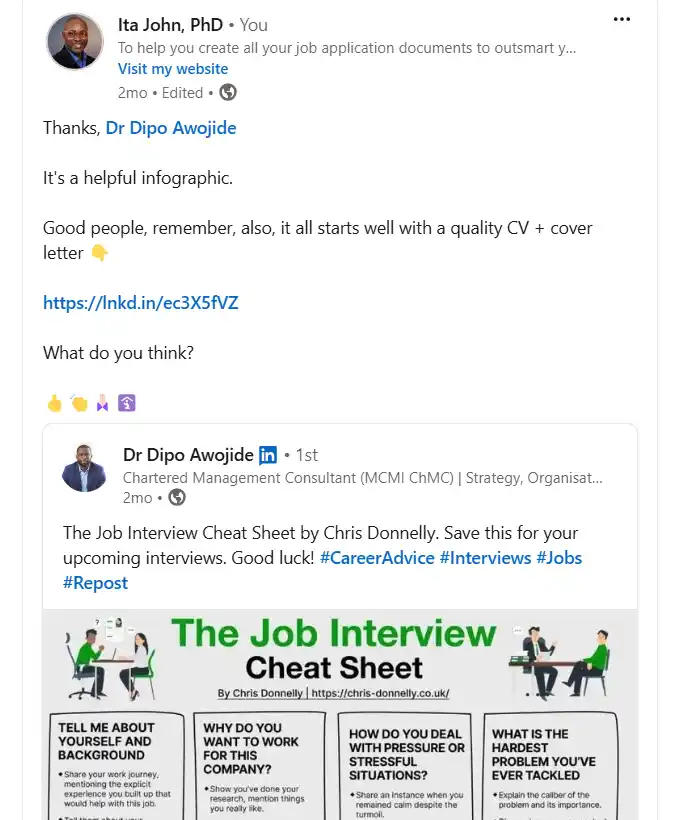
You can also repurpose old content that received a lot of engagement. For brand consistency, your content must be relevant to your industry and target audience.
4. Engage With Relevant Accounts and Posts
Find accounts, industry influencers, and topics that align with your niche and engage them. It could be a simple reply, a like on content, a quote retweet with your thoughts, or a comment on the post. So, feel free to be creative with this.
Engaging with relevant accounts is you saying “I’m open to new connections.“ It is your chance to build stronger relationships, develop beneficial partnerships, connect with new people, and increase your brand’s reach. Eventually, you will get partnership opportunities that will help build your brand.
5. Research Keywords, Hash Tags, and Trending Topics
Reality check:
- Nobody will engage your content online if it’s not visible.
- Nobody will see your content unless you expand your content reach.
- The algorithm will not show your content (to a wider audience) unless your content has relevant keywords and hashtags.
If you want to expand your content reach, then (you must) include keywords and hashtags.
But why?
Keywords and trending hashtags encourage engagement by increasing your content reach and discoverability. This combo makes content easier to discover by linking it to topics people actively search for.
Keywords make content rank higher while hashtags group similar posts under one searchable term. When used well, they connect your content with users interested in that topic. This leads to higher engagement and attracts new followers and potential customers.
For example, on Instagram, a bakery might use hashtags like #VeganDesserts or #GlutenFreeCakes to reach people looking for those specific treats. If someone searches #VeganDesserts, they could find the bakery’s posts even though they don’t follow the account.
Ergo, research the keywords and hashtags related to your niche to get relevant content ideas for your social media posts.
The key step here is to know users’ intent on social media:
The same goes for trending topics.
Jumping on trending topics on social media will make your content popular, drive traffic, and expand your reach. This helps your brand stay relevant. However, ensure the trending topics you discuss are relevant to your brand and industry.
Social media trends don’t last long, so check for trending topics daily. For Tiktok you can find what’s trending in their Creative Center:
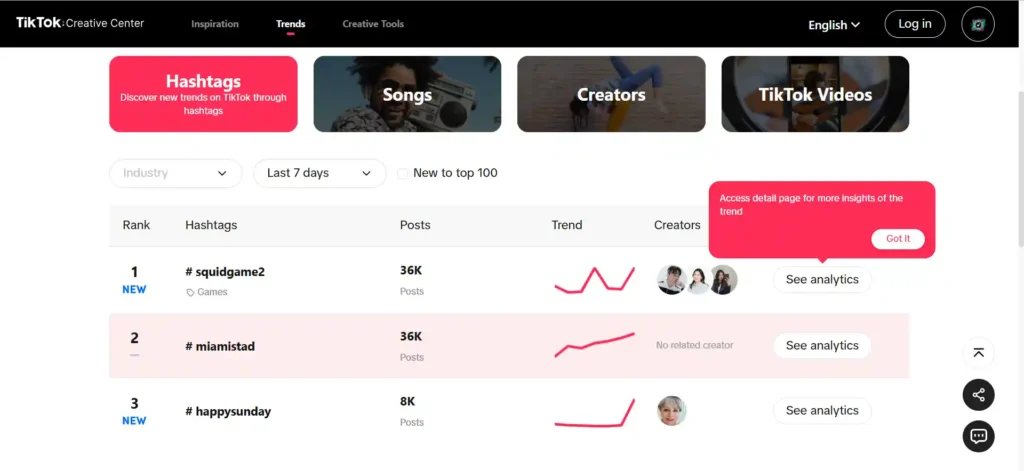
On X (formerly Twitter):
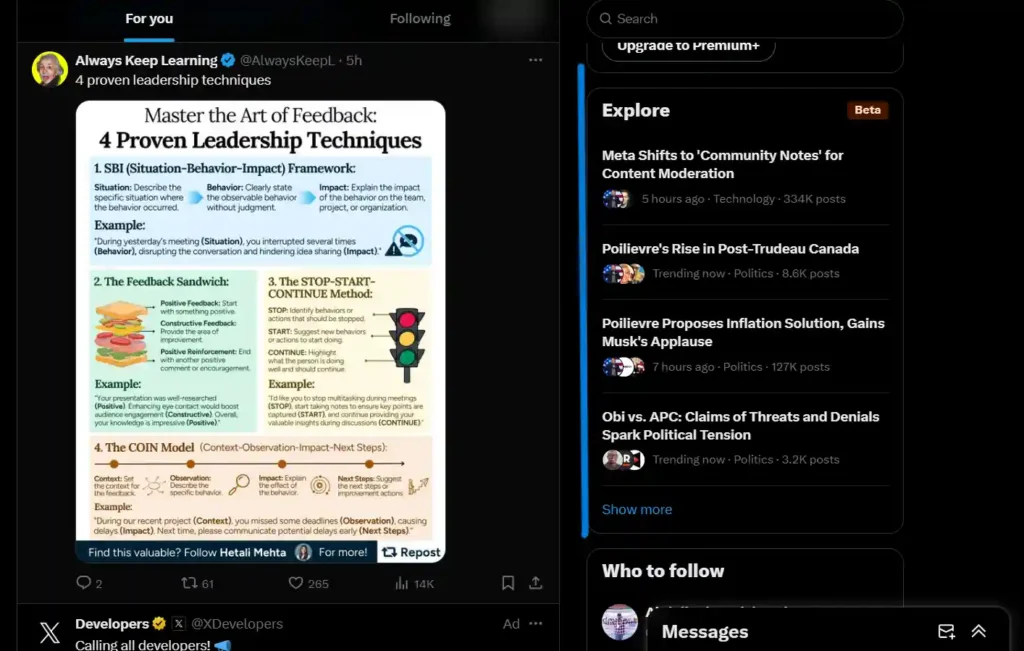
How to find keywords and trending hashtags:
- Use the Search Bar on Any of The Social Media Channels: Platforms like Instagram, TikTok, and X (Twitter) let you search for popular keywords and hashtags directly on the search icon. Click the search icon and start typing a word. Suggestions will show you trending (and related) topics or hashtags.
- Monitor Trending Sections and Tools: Look at trending topics or explore sections on platforms like TikTok’s Discover page or X’s Trending tab. You can also use tools like Hashtagify or RiteTag to find popular hashtags in real-time.
- Follow Industry Leaders and Communities: Check the posts and stories of influencers or brands in your niche. They often use trending hashtags that you can adapt to your content strategy.
Weekly Social Media Marketing Checklist
Here are all the social media activities you need to do on a weekly basis.
1. Create and Schedule Content on Your Content Calendar for the Next Week
Want to avoid scrambling at the last minute?
Then create and schedule posts ahead of time. Scheduling content will keep you from running helter-skelter and ensure consistency.
Your posts should be scheduled weekly. However, find time daily to review your scheduled content and ensure it is ready for the day. You can even make some changes or modifications at the last minute.
Also, you can check for seasonal trends or holidays (e.g. Christmas, New Year, Halloween, Easter, or Summer break), industry events (e.g. AI Conferences, Paris Fashion Week, Met Gala, GameAwards, etc.), and cultural events (e.g. Super Bowl, Olympics, EidMubarak, etc.) to help you develop content ideas.
The key here is knowing the best posting frequency for each channel.
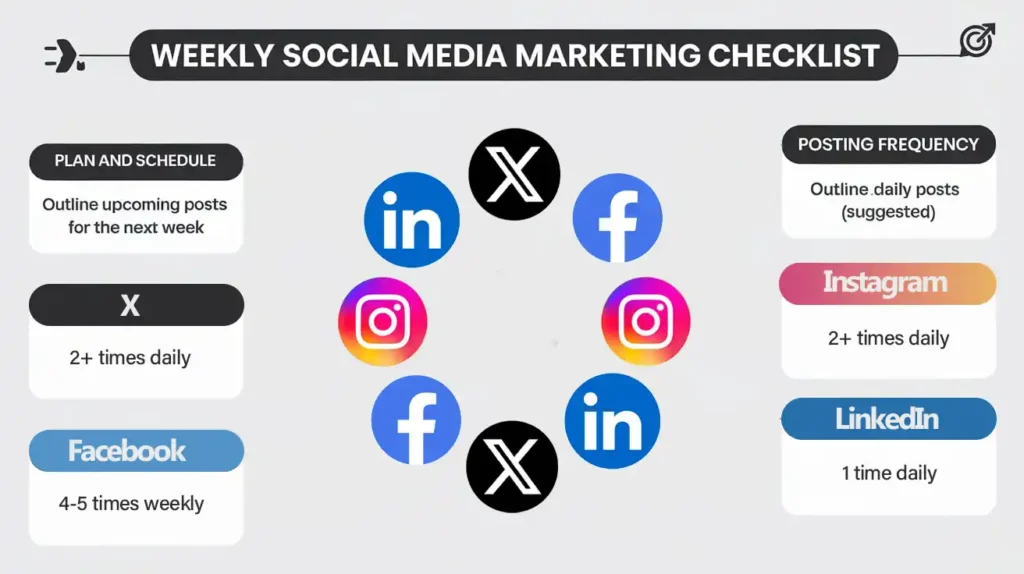
Remember:
Whatever you post must be relevant to your industry and business and resonate with your audience. Otherwise, you risk hurting your brand reputation and (perhaps) offending your customers. Your goal is to have a consistent presence online.
2. Track and Analyze Your Performance Metrics on Social Media Platforms
Analyzing your performance is needed to get a full picture of how effective your strategies are. By analyzing your performance metrics, you can identify the best-performing posts with more engagement and detect negative trends before they get out of hand.
When you track metrics, you will adjust your methods based on what you learn and notice any deviations from the norm. You can check what brought you success/progress and where you need to improve.
When analyzing your performance, focus on these key metrics or stats:
- Engagement: When people engage with your posts, you’ve caught your audience’s attention enough to stop their doom-scrolling. Look at likes, reactions, shares, comments, and saves. Track them all, observe patterns that drive engagement, and decide what to work with.
- Social Media Reach and Impressions: Check how many people saw your content and how often it appeared on their feed. This will show you the unique number of users who viewed your content and the total number of times it was displayed, even if seen multiple times by the same user.
- Click-Through Rates (CTR): This is important if you use social media to direct people to your website (like blog posts or landing pages). Measure how many people clicked on links in your posts or social ads compared to the total number who saw them. This will give you an idea of if your call-to-action (CTA) is successful or not.
- Audience/Follower Growth: This shows the number of people interested in your brand and what it can offer them. Monitor follower counts or new subscribers to see if you’re attracting more people over time or not.
Social platforms all have built-in analytics where you can review your key performance indicators/metrics. However, you can view your analytics in one place with Social Analytics from Semrush Social.
3. Analyze Your Competitors
Taking a sneak peek at what your competitors do weekly will help you know:
- The contents they publish.
- How frequently they post. &
- Their engagement rate.
You can gain inspiration for your social media strategy by looking at the works of others.
Of course, I don’t recommend snooping around your enemy’s backyard too long. However, taking calculated peeks helps you get the tea on their weaknesses, their strengths, and what trends they use to get engagement.
Analyzing your competitors can be as simple as scrolling through your X feed, Instagram or TikTok reels, and YouTube videos. On X, simply create a list of your competitors:
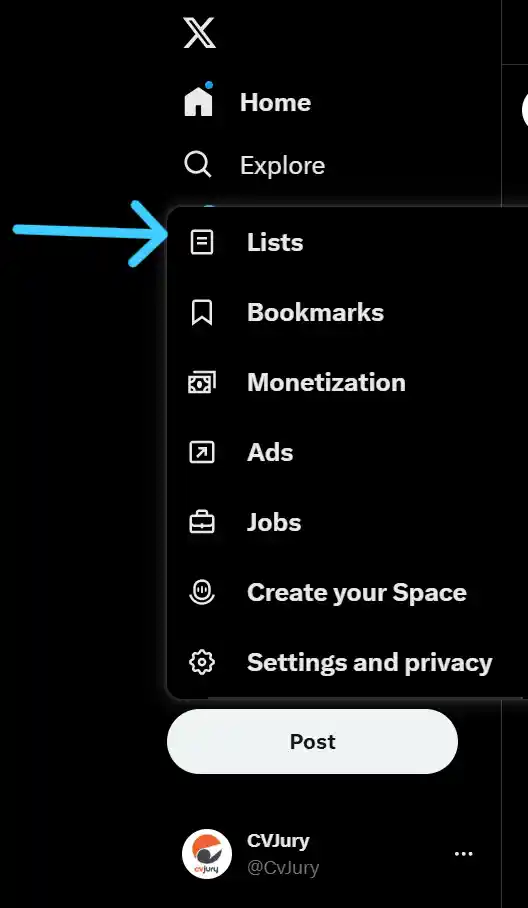
Give the list whatever name you want and discover new lists as well.
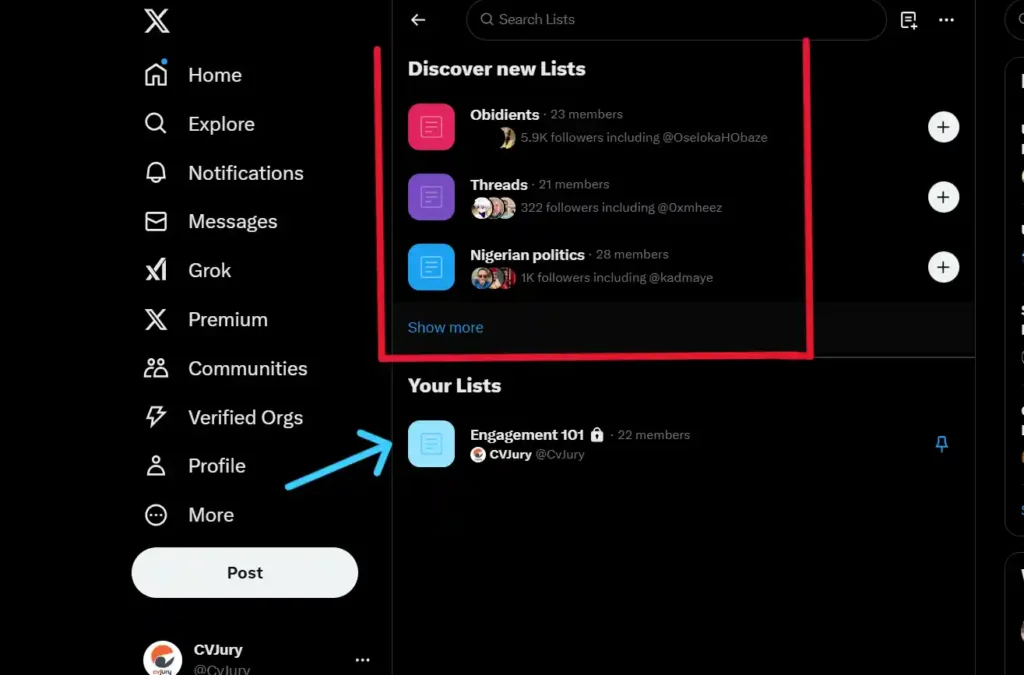
- Current trends
- What social media trends do influencers participate in?
- Algorithm changes
- Topics that generate high levels of engagement
4. Track Weekly Goals
All social content creators and businesses set goals to measure their marketing efforts on social channels. Track your weekly goals as you do your weekly stats. This will help you see better how your results align with your social media goals. For example; your goal is to increase follower growth and engagement by 10% weekly on Instagram. You can experiment with interactive content like polls, questions, and reels in stories on your Instagram posts. Another example could be publishing over 10 posts across your accounts to promote upcoming campaigns, product launches, or events. You can schedule two posts each for Facebook, Instagram, Twitter, LinkedIn, and TikTok to achieve this effectively.5. Connect With an Influencer
Industry influencers are essential for amplifying your credibility and reach. They already have a loyal following. Therefore, their endorsement can make your product or service more appealing and drive conversion rates.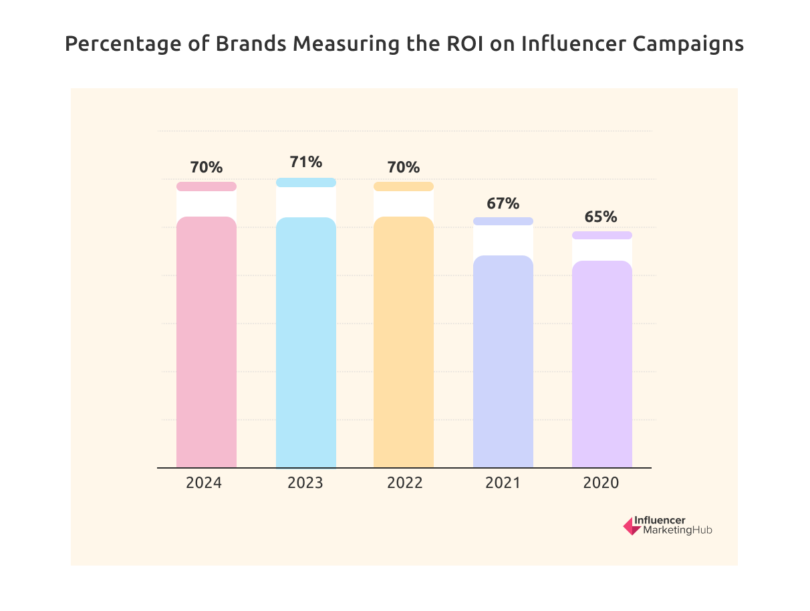 Each week, reach out to influencers whose contents align with your brand and discuss potential collaborations, like sponsored posts or product reviews. Internet users trust user-generated content (UGC) more than any traditional ad. Ergo, leveraging influencers should be part of your marketing strategy.
Each week, reach out to influencers whose contents align with your brand and discuss potential collaborations, like sponsored posts or product reviews. Internet users trust user-generated content (UGC) more than any traditional ad. Ergo, leveraging influencers should be part of your marketing strategy.
Monthly Social Media Marketing Checklist
Here are all the social media activities you should do every month:1. Conduct a Social Media Platform Audit
A social media audit is like a health check for your brand presence. You review all your social profiles to see what’s working, what isn’t, and how you can improve your branding. So, what you’re doing is; you’re tracking and measuring your social media profiles for progress, performance, and consistency. By looking at your content, engagement, and analytics, you can:- Spot gaps, make informed decisions, and plan better strategies to connect with your audiences.
- Check your posting frequency on other social media platforms.
- Measure results like follower growth, referral traffic, and average clicks.
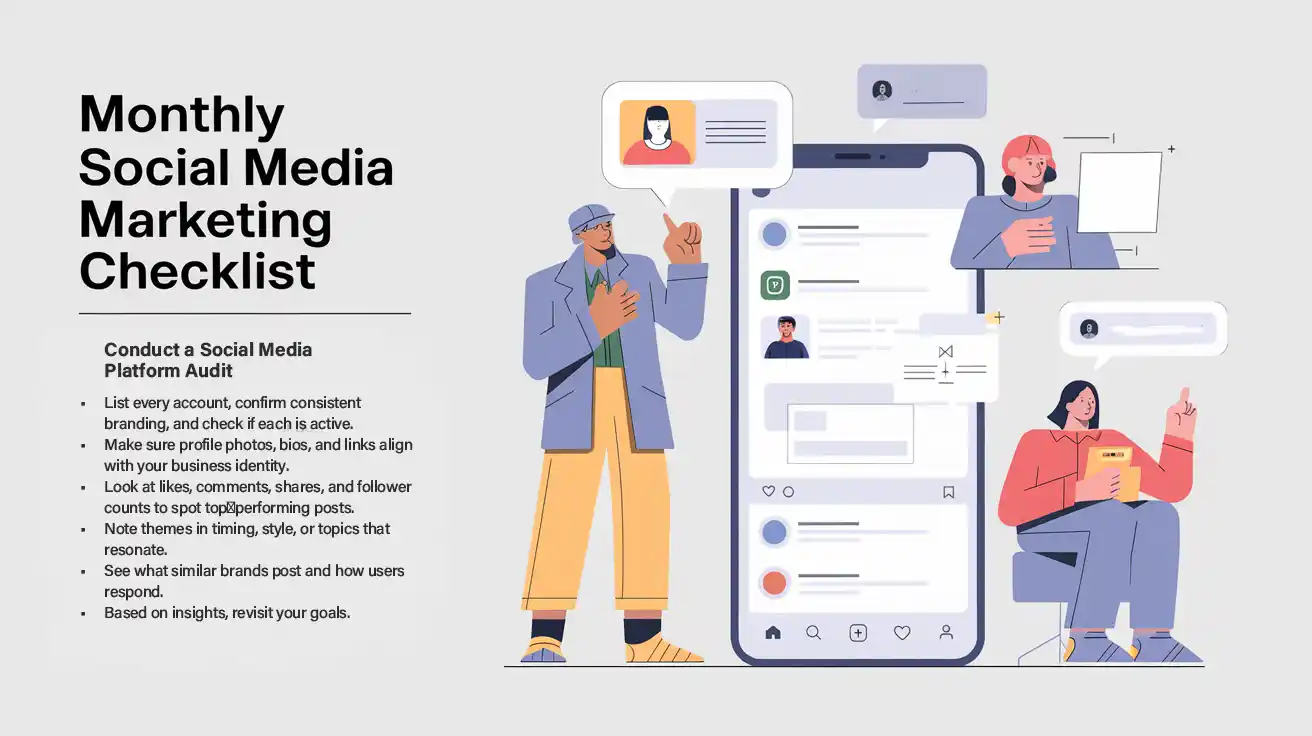
2. Create and Share a Monthly Analytics Report
Everybody gets that nice magical feeling when people engage with their content. But what are the cold, hard numbers? More importantly, why do you need to analyze at all? Conducting a monthly analysis and creating a report gives you an overhead view of your social media marketing strategy. So, you’ll be able to know what’s working and what’s not. By extension, a monthly analytics report gives you a better understanding of the topics and posts that satisfy your goals. With this understanding, you will create content similar to them to make progress. Some people prefer to create a report weekly, which isn’t bad. I recommend you do it monthly. Plus, there are several things you would see better in a monthly report. For instance, you can check which time of day gets the most clicks or comments, such as discovering your audience is more active between 6 PM and 8 PM on weekdays. You can also see what days content generated the most engagement. Or, you can check what all your top engaging content has in common. You can review your content to see if posts with hashtags like #MondayMotivation or #ThrowbackThursday consistently get more likes and shares than others.3. Conduct an Audience Analysis (To Understand Your Audience)
Part of social media management is a deep understanding of your target audience. Identify the platforms your customers use and the type of content they like. Identifying their pain points and preferences is essential for creating content that resonates with them. This is why you must conduct an audience analysis: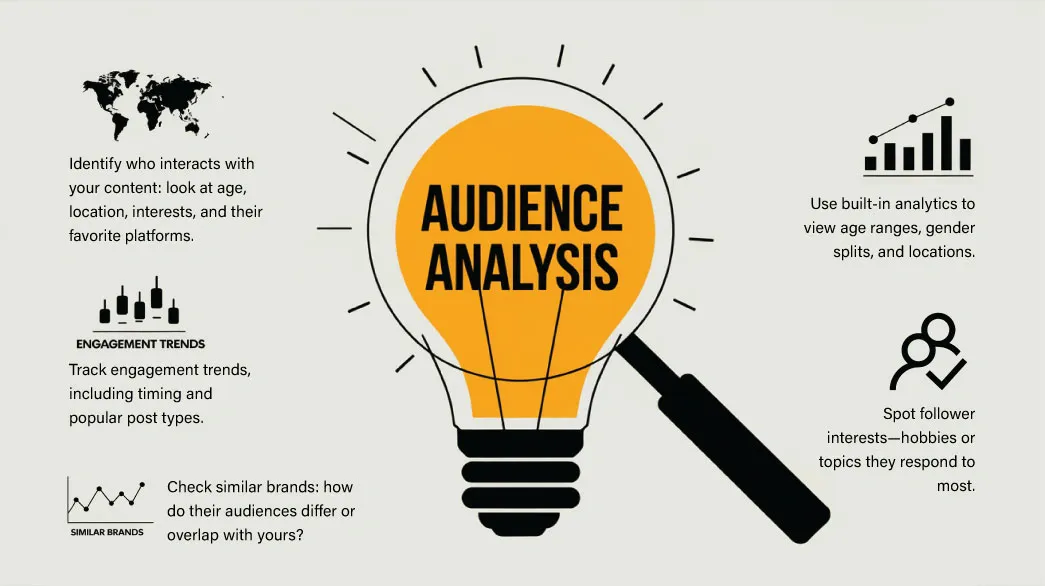 The more you know about their needs and interests, the better your content. In the long run, you will develop loyalty and deeper relationships.
So, start by looking at information about your current followers. You can use social media tools like Meta Business Suite, Semrush Market Explorer, or Google Analytics to gather audience insights. They will give you a report on specific audiences, demographics, gender, and preferences.
The more you know about their needs and interests, the better your content. In the long run, you will develop loyalty and deeper relationships.
So, start by looking at information about your current followers. You can use social media tools like Meta Business Suite, Semrush Market Explorer, or Google Analytics to gather audience insights. They will give you a report on specific audiences, demographics, gender, and preferences.
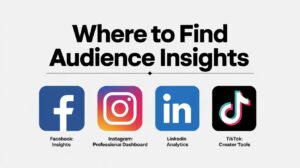
4. Revise and Touch Up Your Social Media Strategy
As a rule of thumb, you should reflect on your performance during the month. Ideally, you should do this at the end of every month.
When you study your social media audit, audience analysis, and monthly analytics, you can identify where your strategy falls short. So, you know what and where needs improvement. Then, you can revise and touch up your strategy ahead of next month.
You should brainstorm content ideas for next month’s content and follow-up strategies. For example, you can try posting more frequently on certain channels than others. Or, you could spend more time exploring what’s trending on social media.
Best Social Media Practices
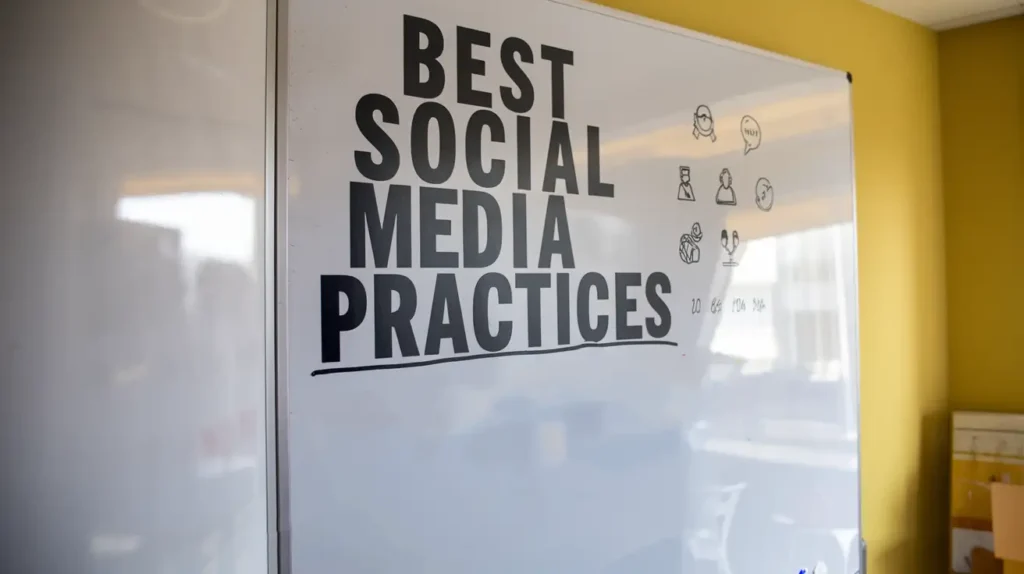
You need a winning social media strategy to grow your brand/business on any social media platform. To create this, consider the following:
1. Set clear goals and metrics
Setting goals gives you a clear direction of where you are headed. It also shows whether your social media efforts align with your company objectives.
For example, if your goal is to grow your email subscribers by 15% in the next quarter, a social media goal could be to boost engagement on posts promoting your newsletter by 20%.
Your goals must be specific, measurable, attainable, relevant, and time-bound (SMART). This will give your social media marketing plan purpose and direction. Thereafter, define your key performance indicators (KPIs) to benchmark progress.

Compile your goals and KPIs on a Google Doc (or arrange them on Google Sheets) and share them with key stakeholders.
2. Focus on the Right Social Media Channels
Some platforms will not give you the results you want.
This is why you must focus on the right platforms. Don’t waste valuable time on any social media platform that won’t give you visibility, maximize engagement, and generate a return on investment.
For example, Let’s say your target audience is young professionals aged 25–34 interested in personal finance and investing. Or recent graduates actively searching for jobs. From your research, LinkedIn, Twitter, and YouTube are likely platforms where they spend the most time engaging with tips, tutorials, and expert advice.
Your recent audience and social media analytics should give you better insight into which channels are more successful. You can use Market Explorer to understand where your audience is active.

3. Create and Use a Content Calendar
Anyone involved in social media management understands the importance of being organized.
That’s why you must create a content calendar.
Using a social media calendar helps you plan ahead and remain consistent. This is a social media management tool that should not be overlooked. When you batch-create content, use a social media content calendar to schedule social media content you plan to post.
Additionally, when you create a content calendar, you can track which days have the best traffic for your social media posts. This makes your work easier.
4. Experiment and Test Content Formats as Much as Possible
Don’t be afraid to explore and experiment frequently.
If you notice your engagement is stagnant, keep things fresh by mixing different content ideas. This will garner engagement and create meaningful discussions among your followers.
Content creation should be fun.
So, test different content formats and see which one generates more leads, conversion rates, and engagement. You can use social media tools like:
- Video/Reels on Instagram and Facebook
- Live videos
- Polls on X, LinkedIn, or Instagram
- Documents
- Carousels
For example, if you usually post text updates on X, consider using polls or adding eye-catching visuals like GIFs or images to your tweets.
Or, if you usually share static infographics on LinkedIn, try posting carousel slides instead to see if they encourage users to swipe through and engage with your content. Or, experiment with asking direct questions in your post to spark comments and discussions.
Additionally, instead of sticking to your regular weekday schedule, test posting on weekends to see if your audience is more active then. Always track metrics and measure results to know what works and what doesn’t.
5. Define the Tone of Your Voice
Your content tone of voice should be consistent with your brand identity across every platform. Yes, your tone of voice should vary between audiences. However, keep it consistent.
Your goal is for your content to resonate with your customers and address their pain points.
6. Use Emojis and Great Visuals
Compliment your content with key visuals to grab attention. Visuals enhance your post and convey information more quickly.
Keep this in mind:
Your key visuals must align with your brand identity. For example, your images or videos should always carry your brand logo.
Another way to elevate your posts is by using emojis. Your content should have well-placed emojis to emphasize or show emotion. However, use them sparingly.
7. Extend Your Reach To Your Target Audience
If you want more people to see your content or for your posts to spread beyond your followers, consider increasing your reach. What you want for your brand is for more unique users to see and engage with your content.
But how can you grow your reach?
Paid ads and boosted posts are one of the fastest ways to reach more people. You can run a campaign by turning best-performing posts into ads. For example, with Facebook Ads Manager, you can boost organic posts so that it reaches users who aren’t in your follower base.
Simply select the post you want to boost and click “Boost post.”
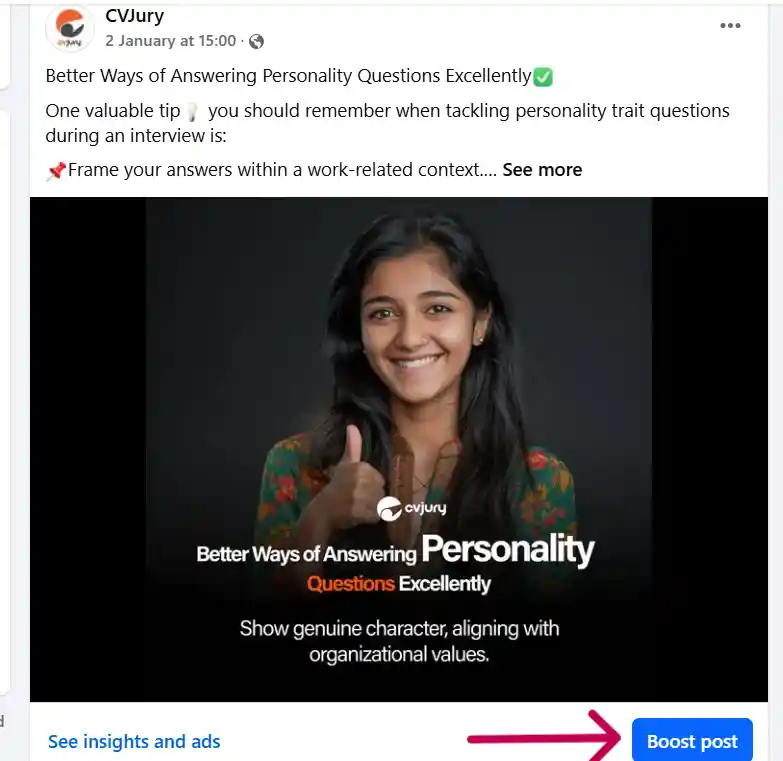
Choose the people you aim to target with this post:
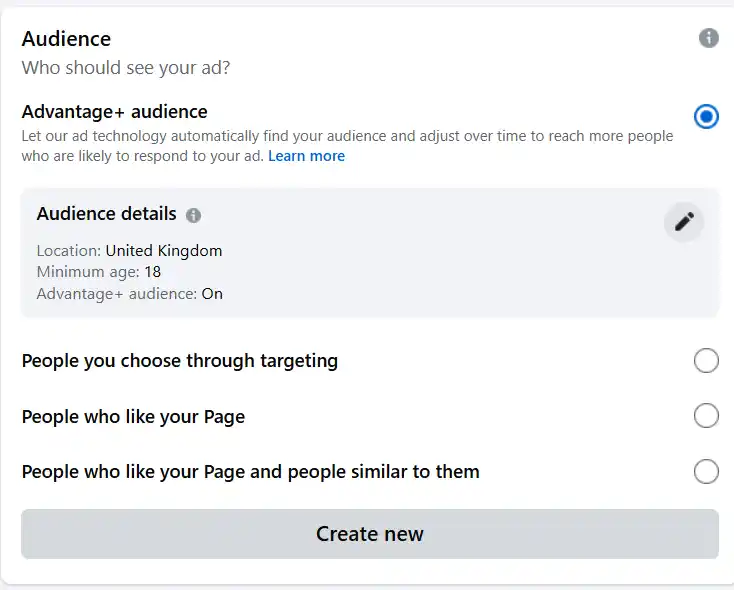
Set the budget and duration of your campaign:
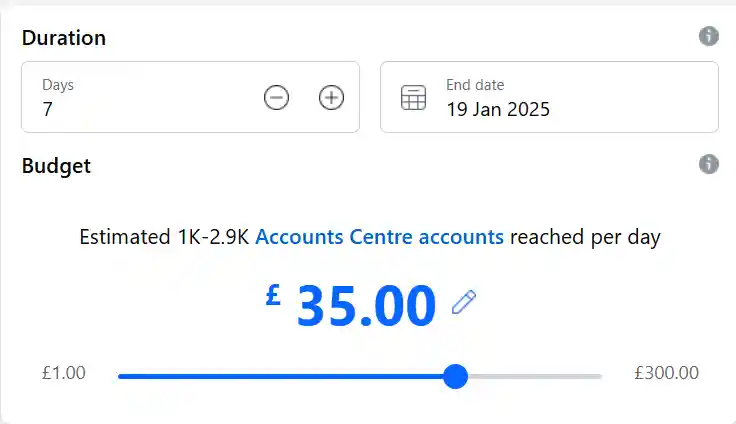
Another way to expand your reach is by running an influencer marketing campaign. When you partner with influencers with a loyal following in your niche, they can introduce your brand to their audience. Tools like Influencer Analytics or Upfluence help you find influencers in your niche.
In this video, Alex Hormozi reveals How to Grow an Audience if You Have 0 Followers:
The Best Social Media Platforms for Your Business
1. Facebook
Facebook is great for businesses looking to connect with many people. It has resources like Pages and Groups that help build a community for your brand. Facebook Ads also lets you target specific customers based on location, interests, and behaviors. You can manage posts, messages, and analytics better with the Meta Business Suite.2. LinkedIn
LinkedIn is perfect for professional networking and B2B marketing. You can connect with industry leaders, share insights, and recruit top talent. With features like LinkedIn Pages and the Campaign Manager you can showcase expertise, run targeted ads, and build credibility within your field. LinkedIn Analytics also provides valuable data to improve your strategy.3. Instagram
Instagram is all about visuals. It is the go-to platform for businesses sharing visual content. Tools like Stories, Reels, and Shopping make it easy to advertise products, run promotions, and drive sales. Instagram Insights helps you track engagement and see what content resonates most, making it simple to refine your approach.4. TikTok
Just like Instagram, TikTok caters to a younger demographic. You can use its short videos and trending challenges as a quick way to boost visibility. TikTok’s Business Centre provides tools for creating ads and tracking campaigns, while the Creator Marketplace helps brands collaborate with influencers for brand awareness. If your content goes viral, the payoff is pretty high.5. X
Although X is way more conversational it is still a good visual engine. With its latest feature Grok AI, you can immediately generate images on the platform and post them with your text. Additionally, you can share quick updates, engage in trending conversations, run ads through the platform’s Ad Manager, and check best-performing tweets with Twitter Analytics.6. YouTube
YouTube is the best platform for long-form video content that educates, entertains, or solves problems for your customers. Social media marketers can share tutorials, product demos, or behind-the-scenes content. YouTube Studio offers tools to edit videos, manage comments, and view detailed analytics on audience engagement, helping you grow your channel and reach more viewers.Wrap It Up: Nail Your Social Media Game in 2025 with This Foolproof Social Media Checklist
Knowing what to do as a social media manager can be tricky, especially for a first-timer. Even experienced social media marketers can feel lost at sea sometimes. So, don’t beat yourself too much. As a social media manager, posting on social media is just the beginning. The real work is in the details. Want to take things a step further? Use a social media management checklist to stay on top of everything. You’ve got the foundation from this practical checklist, so keep practicing and learning. By incorporating the steps in this article, you will create meaningful connections, build a stronger brand, and set yourself apart in no time. We’ve given you the roadmap. All you have to do is follow it. No matter where you started, today is the day to take control. Stick to the checklist, adjust to your taste, and watch your efforts transform everything. The tools are in your hands—now it’s time to make it happen. Your audience is waiting!Need Help with your Social Media Marketing?
Do you feel you need help managing multiple platforms and creating content? Do you need more expertise to stay updated with the latest trends and algorithms? You need a dedicated team to handle community engagement and respond to inquiries instantly. As the leading social media marketing agency in the USA and UK, TechCraft Solution understands the challenges businesses face online. We offer the best social media management services to build your authentic brand. We’ll work closely with you to:- Develop an effective social media strategy aligned with your specific business goals.
- Create valuable and engaging content that aligns with your audience.
- Implement effective community management strategies to build meaningful connections and build brand loyalty.
- Run targeted social media advertising campaigns to maximize reach and get measurable results.
- Continuously monitor performance, analyze data, and provide valuable insights for ongoing optimization.
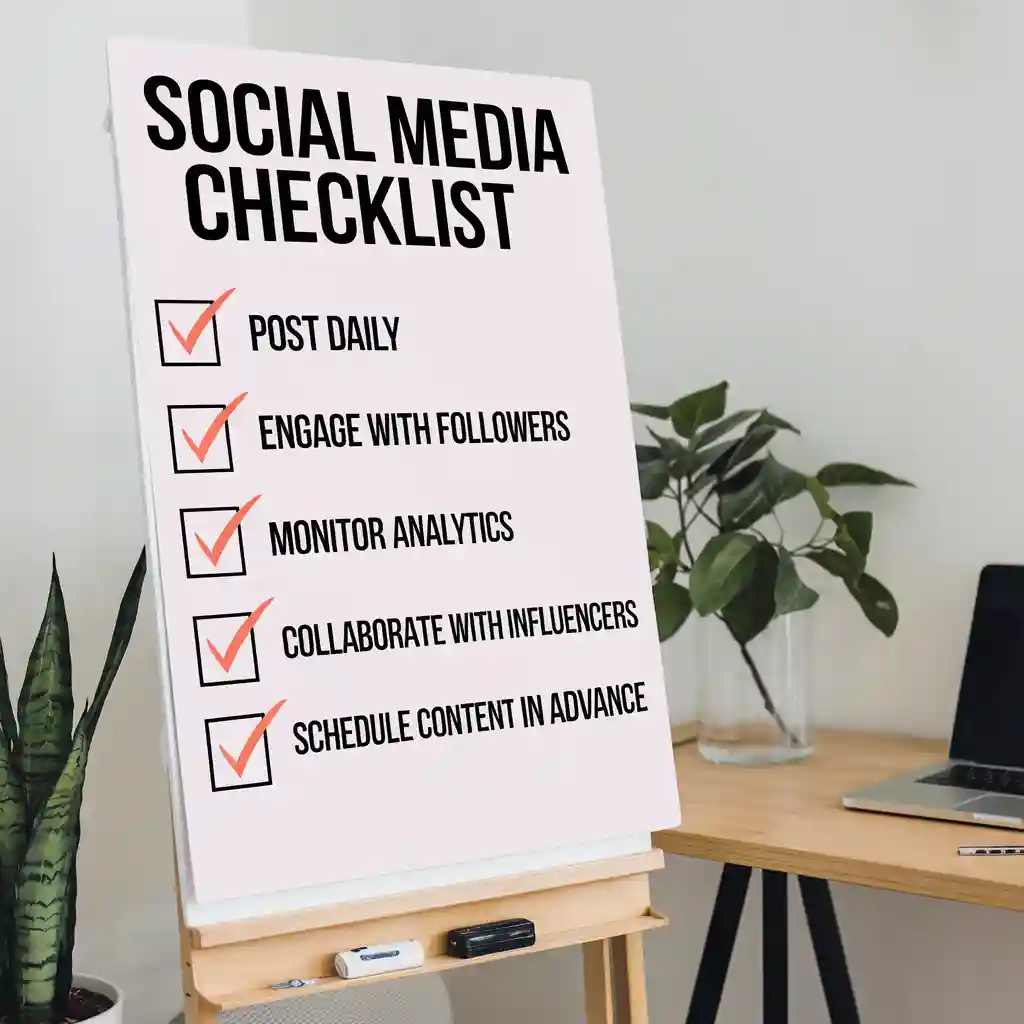
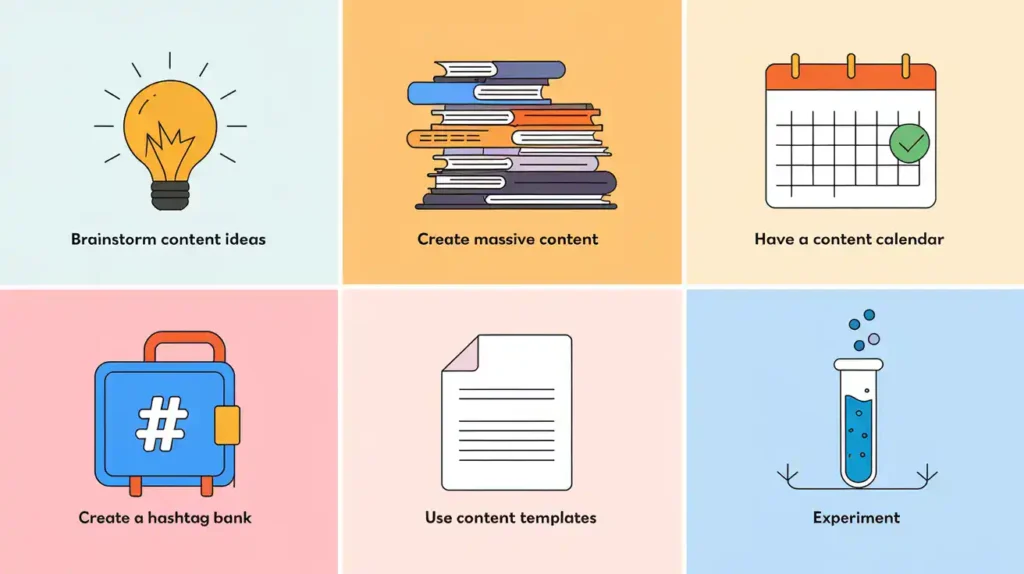
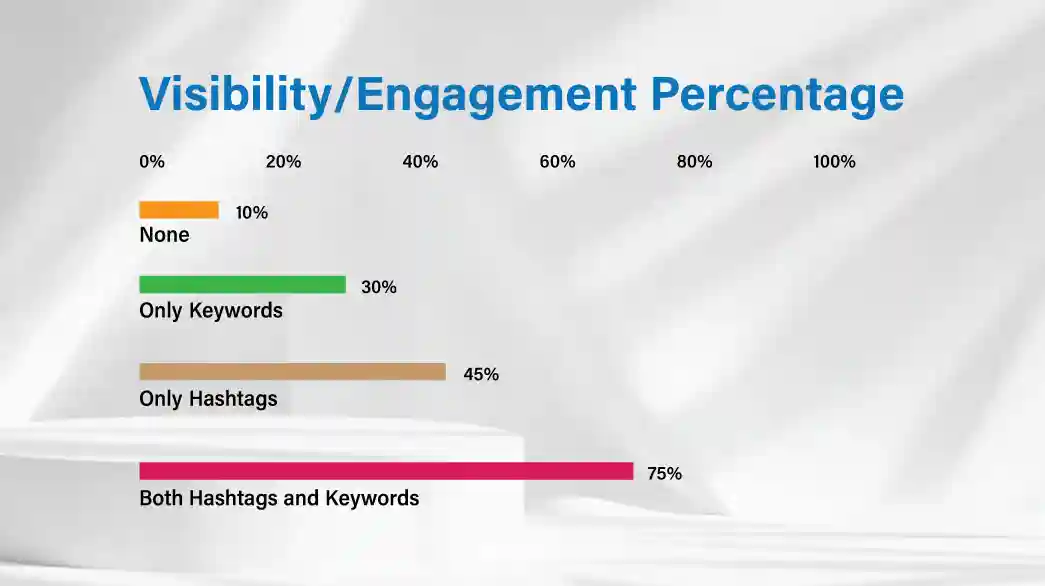
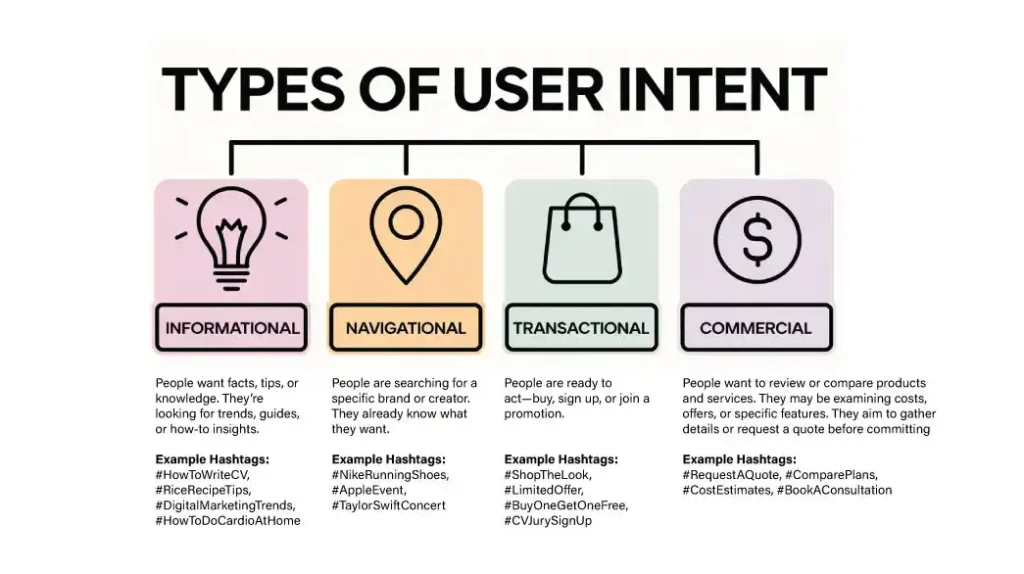
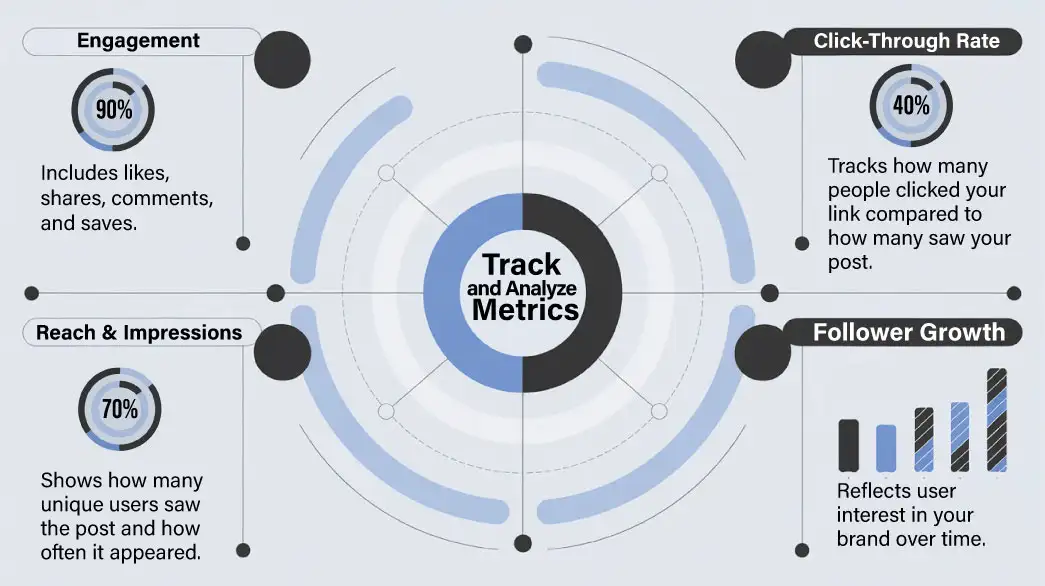
3 Responses
I love how you incorporate personal stories and experiences into your posts It makes your content relatable and authentic
Thanks
This article really broke it down.